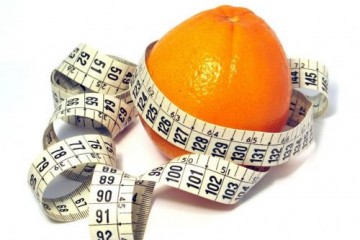How to Lose Weight the Healthy Way
You don't have to starve yourself to lose weight; in fact, you shouldn't. Losing weight the healthy way involves a commitment to your plan and patience. Following guidelines for a healthy approach to weight loss is also key in maintaining your weight once you reach your target. Combining your weight loss plan with ways to control your metabolism can help you to reach your goal more quickly, and still lose your weight the healthy way.
Steps
Part 1 Planning Your Weight Loss Program
-
1
Talk to your doctor about weight loss. Be sure you need to lose weight, and that this is the best time for you to proceed with weight loss. If you are pregnant, or have a medical condition, your body may need added calories to maintain your health, so this is not the time to start losing weight.[1]
- If you have medical conditions such as hypertension, diabetes, or cardiovascular problems, talk to your doctor before starting a diet and exercise plan. Many factors, including age, current weight, and overall physical health, should be discussed with your doctor in order to safely start a diet and exercise plan.[2]
-
2
Set reasonable and realistic goals. Weight loss of 0.5 to 2 pounds per week is a healthy approach. Allow yourself the time you need to reach your weight loss goal, planning on a loss of up to 2 lbs. each week.[3]
- While it may be tempting to pursue fad diets with promises of fast weight loss, a slow and steady approach is the healthiest way to lose weight.[4]
- While fad diets may help you drop weight quickly, they are not sustainable long term and once you stop the fad diet, you often gain back the weight plus more.
- 3 Incorporate your daily calorie target in your plan. Weight loss happens when you burn more calories than you consume. Your doctor can help determine the number of calories to consume each day specific to your body, age, sex, and your lifestyle.[5]
-
4
Do the math. One pound is equal to about 3,500 calories. In order to lose 1 to 2 pounds each week, your daily calorie consumption needs to decrease by about 500 to 1000 calories, or you activity level needs to increase to burn more calories.[6]
- As an example, a moderately active 35 year old female needs to consume about 2000 calories per day to maintain her current weight. A target goal of 1400 to 1600 calories per day will create a situation of weight loss for this person.[7]
- Daily calorie goals factor in age, sex, and level of physical activity. Some medical conditions can be a factor that may also need to be considered.[8]
- 5 Avoid setting your daily calorie goal too low. This can actually prevent you from losing weight. When you skip meals or consume too few calories, your body starts to store calories as fat instead of burning them.[9]
-
6
Come up with a plan that fits your own likes and dislikes. Many healthy weight loss plans already exist and can be tweaked to suit your own preferences and needs. Whether you tweak a formal diet plan or come up with your own, be sure it is suited to you, and is a plan you can live with for a long time, not just for a few months.[10]
- For a successful healthy lifestyle change, it is important that your new plan fit into your life without too much difficulty. Adjusting how you eat and exercise is one thing, completely changing to foods you don't normally eat and exercises you don't enjoy will most likely not be successful long term.
- 7 Consider your past experience with weight loss plans. As you develop your plan, incorporate what worked, and leave out what did not work.[11]
- 8 Build in some flexibility. Add your own personal preferences, and include flexibility in both your food and physical activity choices. Plus, consider your preference to diet all alone or if you prefer support from a friend or group.[12]
- 9 Create a plan that fits your budget. Some diet programs involve added costs. The added expense may be from a gym membership, joining a specific group, purchasing specific food items like supplements or meals, or attending regular appointments or group meetings.[13]
- 10 Increase your physical activity and make this a part of your plan. Consider expanding on activities you already enjoy, like walking, Zumba dancing, biking, or yoga. Establish a physical activity routine that you can live with, for the long run. An exercise routine that includes aerobic activity and muscle development is ideal, but just increasing your level of activity is a great place to start.[14]
- 11 Set your activity goal. Work towards 150 minutes or more per week of moderate physical activity, or 75 minutes of more vigorous aerobic activity or exercise, spread evenly throughout the week.[15]
-
12
Recognize the difference between physical activity and exercise. Physical activity includes the things you already do every day, such as walking, housework, yard work, and running around in the yard with the kids, grandkids, or the family pet. Exercise involves structured, scheduled, and repetitive forms of activity that you do regularly.[16]
- However, seeking to add additional physical activity (ex: taking the stairs rather than the elevator, walking rather than driving, etc.) can be a great way to reach your goals.
-
13
Calculate your current and target BMI. Your doctor can tell you what your body mass index, or BMI is. A healthy BMI range is between 18.5 and 25.[17][18]
- The formula to calculate BMI is a little confusing, but if you want to calculate your BMI, then follow these steps. Your BMI is your weight in kilograms (not pounds) divided by your height (in centimeters) squared.[19]
- Here is an example. For someone that is 5 feet 6 inches tall and weighs 165 pounds, the formula reveals the BMI to be 27.3.[20]
- Convert the pounds into kilograms. Do this by multiplying the weight in pounds by 0.45. So 165 x 0.45 = 74.25. Next, convert the height to centimeters. 5 feet 6 inches is 66 inches. Multiply the 66 by 0.025 to get 1.65. Then square that number by multiplying it against itself, so 1.65 x 1.65 = 2.72. Divide the new weight number by the new height number; 74.25 ÷ 2.72 = 27.3. This person’s BMI is 27.3.[21]
- 14 Commit to your plan. Successful weight loss requires a commitment to yourself to stick with your plan for the long term.[22]
- 15 Create a written contract. Some people find it helpful to put your plan in writing. Include why you want to lose the weight, the plan itself, how much weight you want to lose, and your target date to reach your desired weight. Then sign it as if you are signing a contract.[23]
Part 2 Developing Your Food Guidelines
-
1
Include items from each food group, for every meal, in your plan. The 5 food groups include fruits, vegetables, grains, protein, and dairy. Your plate should be halfway covered with green vegetables and fruits, and the other half with protein and grains. The best dairy products to include in your diet are fat-free (skim) and low-fat (less than 1% fat).[24]
- Good protein sources include lean meats, beans, and fish. Nuts, seeds, and eggs are also protein sources.[25]
- Try to consume 3 servings per day of dairy products. Try to avoid cream cheese, cream, and butter.[26]
- Choose mostly grain products made from whole-grain. Some examples include whole-wheat flour, oatmeal, and brown rice.[27] Avoid packaged oatmeal, which often contains a lot of sugar.
- Fruits and vegetables contain fewer calories than most foods, and are great sources of nutrients, vitamins, and minerals. While fruits are a great choice, they do contain calories and sugars, so limit your daily intake to about 4 servings, which is about 2 cups.[28]
- 2 Avoid empty calories. Solid fats and sugars add calories but no nutrients to the foods we eat. Examples of foods with empty calories include cakes, cookies, pastries, pizza, ice cream, sodas, sports drinks, fruit drinks, sausage, hot dogs, and bacon.[29]
-
3
Choose healthy frozen prepared dinners. Clearly, preparing your meals with fresh ingredients is the best and healthiest way to go. But everyone has days when cooking meals from scratch just doesn’t fit into the schedule. Frozen dinners have evolved over time, and there are some healthy options out there.[30]
- Follow these basic guidelines as you select frozen meals. Choose meals that include servings of lean meat, fish, or poultry, vegetables, and whole grains. Try to target meals that have 300 to 350 calories, 10 to 18 grams of total fat, less than 4 grams of saturated fat, less than 500 mgs of sodium, 5 grams or more of fiber, 10 to 20 grams of protein, and about 10% of the recommended daily values for vitamins and minerals.[31]
- 4 Include cultural and ethnic foods in your plan. Specific cultural or ethnic preferences are a way of life for many people. Include your favorite, but healthy, cultural and ethnic food choices in your weight loss plan.[32]
- 5 Drink plenty of water. While drinking a lot of water is a big part of some diet programs, others place less emphasis on the amount, and just emphasize the importance of water intake for reasons of general health. Some experts report that drinking water when you are hungry helps you to feel full, and therefore controls that cue your stomach sends to your brain that you need to eat.[33]
- 6 Avoid sugary drinks, sodas, energy drinks, and sport beverages. Beyond drinking plenty of water, include coffee and tea, minus the added sweeteners, as part of your plan. Limit your intake of diet drinks, milk other than skim, fruit juice, and alcohol.[34]
Part 3 Making Lifestyle Changes
-
1
Break your old food habits. Emotional or comfort eating gets in the way of nutritional eating. Think about healthy foods you like that can replace your past unhealthy comfort foods.[35]
- Look up healthy recipe swaps for your favorite dishes so you won't feel so restricted.
- 2 Pay attention to how foods make you feel physically. Eating something fried might taste good today, but it might not feel so good the next morning.[36]
- 3 Slow down as you eat. Your stomach will start to feel full if you slow down as you eat. Have a conversation with someone, or put the fork down between bites, to allow your stomach to tell your brain you are getting full.[37]
-
4
Read the labels. Be aware of what you plan to eat, and read the nutrition labels to be sure you are eating what you planned.[38]
- Some packaging can be misleading for marketing purposes, so looking at the nutrition label is essential.
-
5
Talk about food differently. Some foods are more pleasant than others, no doubt. Take control of experiencing new foods by removing the words “I can’t eat that”, and instead say “I don’t eat that”. By changing how you talk about food, it puts you in control of choosing foods you do not routinely eat.[39]
- Instead of talking about the foods you can no longer have, talk about all of the foods your are adding in like fruit, vegetables, lean proteins, etc. Shifting your mindset from restriction to addition can make a big difference.
- 6 Practice healthier eating every day, and all day. Eat breakfast, plan ahead so you know what you will eat when you get hungry, avoid over-eating which can happen when watching TV, and eat the healthy food choices first. Other routines that can help include eating smaller meals, or snacks, throughout the day instead of 3 larger meals.[40]
- 7 Weigh yourself once a week. The scale can help you to tweak your plan if you need to, and to stay on track with meeting your goal.[41]
- 8 Set up your pantry and kitchen to help you. What you can see in your cabinet, or can easily reach for, may not always be the best choice. Keep fruit on the counter and chopped veggies in the fridge. Easy access to healthy choices can help avoid unhealthy snacking.[42]
- 9 Reduce temptation. Get rid of the cookies and ice cream. Having the tempting foods within reach can pull you away from your plan.[43]
-
10
Use smaller plate sizes. Smaller plates can help with portion control, decreasing the number of calories you consume at mealtime. Always eat off a plate as opposed to out of a box, bag or carton.[44]
- You can pre-portion out servings of snack foods and leave them in your pantry to prevent over eating from the container. Grocery stores also have a lot of pre-portioned options.
- 11 Get plenty of sleep. People that get enough sleep burn up to 5% more calories at rest than people that do not get a good night’s sleep. Plus, getting the sleep you need increases the amount of fat you lose compared to people that sleep less than 6 hours each night.[45]
-
12
Get back on track after a setback. Life happens. Weddings, covered dish dinners, birthday parties, game-day snacks, or a night out on the town can all involve eating, or drinking, calories that are not in your plan.[46]
- Think about what you could have done differently, and plan ahead so you will be ready for those challenging events next time.[47]
- Avoid the "all or nothing" mentality. Just because you messed up once, doesn't mean you can spiral out of control and have anything else you want. It happened, move on and don't be so hard on yourself.
-
13
Ask for help. Talking to your friends and family about your weight loss plan can help you stay focused on your goal. You may have a friend that will want to join you in losing weight. Support groups are also available that can provide encouragement, as well as personal tips on struggles they encounter.[48]
- Sharing your goals can also prevent others from being bad influences when know you are serious about losing weight.
Part 4 Asking Your Doctor for Help
- 1 Take prescription weight loss medications. Talk to your doctor to determine if prescription drugs for weight loss are right for you. The FDA has recently approved several agents that can help with weight loss. Using prescription products will depend on your existing medication regimen, any medical conditions you may have, and the amount of weight you need to lose.[49]
- 2 Avoid products that are available over-the counter, unless your doctor agrees. Over-the-counter weight loss products have not been studied and tested for efficacy the way prescription-only products have been. Your doctor may consider over-the-counter products for you, but it is important to discuss this with your doctor before your try this type of product.
-
3
Consider forms of surgery. For some people, considering surgical options may be the safest and most effective way to reach his or her weight loss goal. Only your doctor can properly evaluate your condition and determine if these options are right for you.[50]
- Four procedures are commonly done to help people lose weight. This type of procedure is called bariatric surgery. Two primary functions are provided by the available procedures. [51]
- The 2 functions include restriction, which physically limits the amount of food the stomach can contain, and malabsorption, which shortens the small intestine to reduce the amount of calories and nutrients the body absorbs.[52]
- The 4 commonly performed procedures are called roux-en-Y gastric bypass, laparoscopic adjustable gastric banding, sleeve gastrectomy, and duodenal switch with biliopancreatic diversion.[53]
- 4 Talk to your doctor about your medications. Your doctor may be able to help you, even though you do not realize it. In some cases, you may be taking prescription medications that cause weight gain or increase your appetite. By talking to your doctor about your weight loss goals, some of your medications can possibly be changed, or the dose adjusted, to help you achieve your goal.
- 5 Discuss your exercise plan with your doctor. Depending on how much weight you need to lose, any existing medical conditions, and your age, your doctor can help to guide you in exercise and activity options that are safe for you. Healthcare professionals, like your doctor or a registered dietician, are great resources for information, guidance, and support.[54]
-
Top 10 Foods to Curb your Appetite
Beat Emotional Binge Eating by Eating Stress eating can result
-
Weight Loss Tips So Simple You Can Start Today!
TIP! Stick with low-calorie food items that are similar to wh
-
How To Motivate Your Husbands Weight Loss
First, dont push. Hell only think youre nagging him, and it will
-
How to Perform Self Hypnosis
Self-hypnosis is a naturally occurring state of mind which can be def
-
How to Exercise a Fat Pony to Help Weight Loss
Riding a horse or pony that is overweight can be a challenging and f
-
News Pulse: What Your Food Cravings Say About You
Does Your Doughnut Craving Have A Deeper Meaning? [The Huffington Post
- DON'T MISS
- Weight Loss Tips - How To Lose Weight Safely And Naturally
- Drop Those Pounds With These Great Tips
- 5 Ways To Make Better Food Choices, According To Nutritional Psychologists
- How to Jump Start the Atkins Diet
- Good Tips For Taking Off Unwanted Weight
- Why You Can’t Kick Your Candy Habit
- Weight Loss Rule: No Food After 7 PM
- Weight Loss Tip #74 – Walk for 20 minutes before dinner
- Weight Loss Tip #95- Participate in a race with your friend
- Weight Loss With No Dieting, No Pills And Even No Hard Excercises




